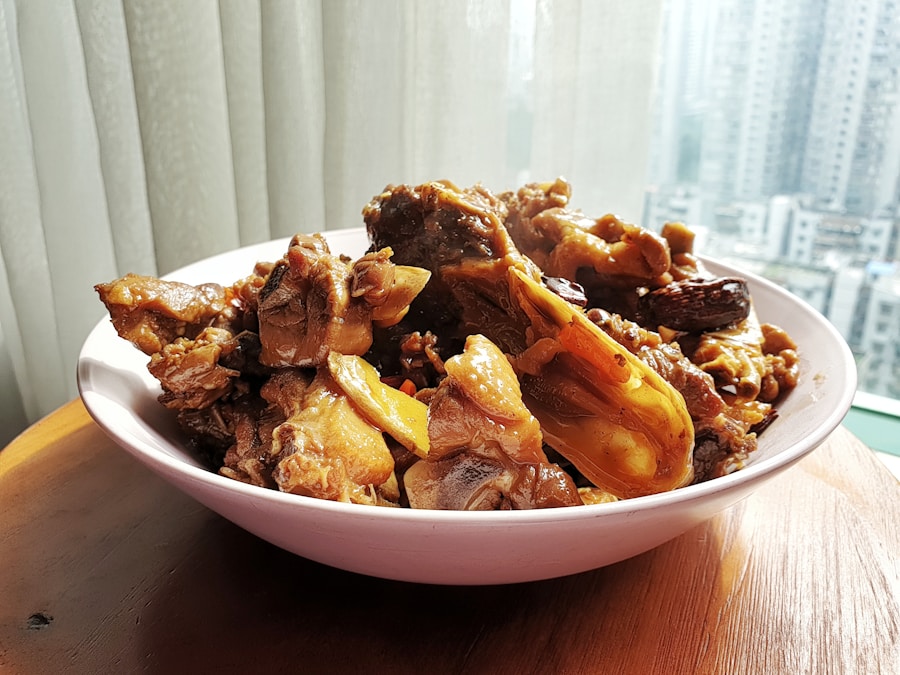Exploring the Delicious World of Adobo
Description
Adobo, a dish that has become synonymous with Filipino cuisine, boasts a rich history that intertwines with the cultural tapestry of the Philippines. The term “adobo” is derived from the Spanish word “adobar,” which means to marinate or season. This connection to Spanish colonial influence is significant, as the Philippines was under Spanish rule for over three centuries, from 1565 to 1898.
During this period, various culinary practices were introduced, and adobo emerged as a fusion of indigenous cooking methods and Spanish techniques. The original adobo was likely a method of preserving meat through marination in vinegar, salt, and spices, a practice that predated Spanish colonization. The indigenous peoples of the Philippines had their own methods of cooking meat, often using vinegar and local spices.
When the Spanish arrived, they recognized the potential of these techniques and began to incorporate their own ingredients, such as soy sauce and garlic.
Historical accounts suggest that adobo was not just a dish but a way of life, reflecting the agricultural practices and available resources of various regions.
As the dish evolved, it became a staple in Filipino households, often prepared for special occasions and family gatherings, symbolizing unity and tradition.
Key Takeaways
- Adobo has a long history dating back to the Spanish colonization of the Philippines, where the cooking method was used to preserve meat.
- There are various regional variations of adobo across the Philippines, with each region adding its own unique twist to the dish.
- The key ingredients in adobo include vinegar, soy sauce, garlic, and bay leaves, which give the dish its signature tangy and savory flavor.
- To perfect your adobo at home, it’s important to marinate the meat for at least 30 minutes and to simmer it slowly to allow the flavors to develop.
- Get creative with adobo by trying out innovative twists such as adobo fried rice, adobo tacos, or adobo pizza. Pair your adobo with steamed rice, pickled vegetables, or a refreshing side salad to complement its rich and savory flavors.
Regional Variations: Exploring the Different Styles of Adobo Across the Philippines
The beauty of adobo lies in its regional variations, each reflecting the unique cultural influences and local ingredients of different areas in the Philippines. In Luzon, particularly in the northern regions, adobo is often characterized by its use of soy sauce and a more pronounced garlic flavor. The Ilocano version, known as “adobo nga iloko,” incorporates local ingredients such as sugarcane vinegar and sometimes even includes hard-boiled eggs or potatoes.
This variation highlights the agricultural bounty of the region and showcases how local preferences shape culinary practices. In contrast, the Visayas region offers its own take on adobo, often featuring a sweeter profile due to the use of coconut vinegar and sometimes even pineapple. The adobo from this area may include seafood or chicken, reflecting the coastal lifestyle of many Visayans.
Meanwhile, in Mindanao, adobo can take on a more complex flavor profile with the addition of spices like turmeric or even coconut milk, resulting in a dish that is both aromatic and rich. These regional differences not only showcase the diversity of Filipino cuisine but also illustrate how geography and culture influence food preparation and consumption.
The Key Ingredients: Understanding the Flavors and Techniques that Make Adobo Unique

At its core, adobo is defined by its key ingredients: meat (commonly chicken or pork), vinegar, soy sauce, garlic, bay leaves, and peppercorns. The choice of meat can vary widely depending on personal preference or regional availability. Chicken adobo is perhaps the most recognized version globally, but pork adobo holds its own in terms of flavor and texture.
The marination process is crucial; it allows the meat to absorb the tangy notes of vinegar and the umami depth of soy sauce, creating a harmonious balance that is both savory and slightly acidic. Vinegar serves as a natural preservative and is integral to the dish’s identity. Different types of vinegar can be used, ranging from cane vinegar to coconut vinegar, each imparting its unique flavor profile.
Garlic is another essential component; it not only adds depth but also enhances the overall aroma of the dish. The use of bay leaves and whole peppercorns introduces an earthy quality that rounds out the flavors. The cooking technique itself—simmering the marinated meat until tender—ensures that all these elements meld together beautifully, resulting in a dish that is both comforting and satisfying.
Cooking Tips and Tricks: How to Perfect Your Adobo at Home
| Adobo Ingredient | Measurement |
|---|---|
| Chicken thighs | 1 kg |
| Soy sauce | 1/2 cup |
| Vinegar | 1/2 cup |
| Garlic | 5 cloves, minced |
| Bay leaves | 3 pieces |
| Peppercorns | 1 teaspoon |
| Brown sugar | 1 tablespoon |
| Water | 1 cup |
To achieve the perfect adobo at home, attention to detail during preparation is key. One essential tip is to allow the meat to marinate for an extended period—ideally overnight. This not only enhances flavor but also tenderizes the meat, making it more succulent when cooked.
When marinating, consider adding additional spices or aromatics such as onions or ginger to elevate the flavor profile further. Experimenting with different vinegars can also yield interesting results; for instance, using apple cider vinegar can introduce a subtle sweetness that complements the savory elements. When it comes to cooking, patience is vital.
Slow-cooking adobo allows for deeper flavor development as the meat absorbs the marinade while becoming tender. Some cooks prefer to sear the meat first for added texture before simmering it in the marinade; this technique can create a delightful contrast between crispy edges and tender insides. Additionally, adjusting the balance of vinegar and soy sauce according to personal taste can lead to a more customized dish.
Finally, serving adobo with a side of steamed rice is traditional; however, consider garnishing with fresh herbs or chili for an added layer of complexity.
Creative Twists: Innovative Ways to Enjoy Adobo Beyond the Traditional Recipe
While traditional adobo holds a special place in Filipino hearts, innovative chefs and home cooks alike have begun to explore creative twists on this beloved dish. One popular adaptation is adobo fried rice, where leftover adobo is sautéed with day-old rice, vegetables, and an egg for a quick yet flavorful meal. This method not only minimizes food waste but also transforms classic flavors into a new culinary experience.
Another exciting variation is adobo tacos, where shredded adobo meat is served in soft tortillas alongside fresh toppings like cilantro, onions, and avocado. This fusion approach highlights how adobo can transcend cultural boundaries while still honoring its roots. Additionally, some adventurous cooks have experimented with adobo-inspired sauces for grilled meats or vegetables, infusing dishes with that signature tangy-salty flavor without adhering strictly to traditional preparation methods.
These creative interpretations showcase adobo’s versatility and its ability to adapt to contemporary culinary trends.
Pairing Suggestions: Discovering the Best Complements for Your Adobo Feast

Pairing adobo with complementary dishes can elevate your dining experience significantly. A classic accompaniment is steamed white rice; its neutral flavor serves as a perfect canvas for soaking up the rich sauce of adobo. For those looking to add variety to their meal, consider serving it alongside garlic fried rice or even coconut rice for an added layer of flavor.
Vegetable sides also play an essential role in balancing out the richness of adobo. Dishes like sautéed greens—such as bok choy or spinach—provide a refreshing contrast while adding nutritional value to your meal. Pickled vegetables are another excellent choice; their acidity cuts through the richness of adobo and adds brightness to each bite.
For those who enjoy a bit of heat, serving adobo with spicy chili sauce or fresh sliced chilies can enhance the overall flavor profile while catering to those who appreciate a kick in their meals. In conclusion, adobo stands as a testament to the rich culinary heritage of the Philippines, embodying both tradition and innovation through its diverse regional variations and adaptations. Whether enjoyed in its classic form or reimagined in contemporary dishes, adobo continues to capture hearts and palates around the world.
FAQs
What is Adobo?
Adobo is a popular Filipino dish that involves marinating meat, seafood, or vegetables in a mixture of vinegar, soy sauce, garlic, and other seasonings, and then simmering it until tender.
What are the main ingredients in Adobo?
The main ingredients in Adobo typically include vinegar, soy sauce, garlic, bay leaves, and black peppercorns. The dish can be made with various proteins such as chicken, pork, beef, or seafood.
How is Adobo cooked?
Adobo is typically cooked by marinating the protein in the vinegar and soy sauce mixture for a few hours or overnight, and then simmering it in the marinade until the meat is tender. It is often served with rice.
Is Adobo spicy?
Adobo can be made spicy by adding chili peppers or hot sauce to the marinade. However, the traditional recipe is not inherently spicy.
What is the origin of Adobo?
Adobo is a traditional Filipino dish that has its roots in Spanish cuisine. The cooking method of marinating and stewing meat in vinegar and spices was introduced by the Spanish during their colonization of the Philippines.





